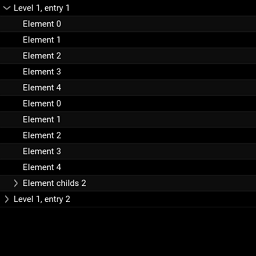Table Of Contents
Tree View¶

New in version 1.0.4.
TreeView is a widget used to represent a tree structure. It is
currently very basic, supporting a minimal feature set.
Introduction¶
A TreeView is populated with TreeViewNode instances, but you
cannot use a TreeViewNode directly. You must combine it with another
widget, such as Label,
Button or even your own widget. The TreeView
always creates a default root node, based on TreeViewLabel.
TreeViewNode is a class object containing needed properties for
serving as a tree node. Extend TreeViewNode to create custom node
types for use with a TreeView.
For constructing your own subclass, follow the pattern of TreeViewLabel which
combines a Label and a TreeViewNode, producing a TreeViewLabel for
direct use in a TreeView instance.
To use the TreeViewLabel class, you could create two nodes directly attached to root:
tv = TreeView()
tv.add_node(TreeViewLabel(text='My first item'))
tv.add_node(TreeViewLabel(text='My second item'))
Or, create two nodes attached to a first:
tv = TreeView()
n1 = tv.add_node(TreeViewLabel(text='Item 1'))
tv.add_node(TreeViewLabel(text='SubItem 1'), n1)
tv.add_node(TreeViewLabel(text='SubItem 2'), n1)
If you have a large tree structure, perhaps you would need a utility function to populate the tree view:
def populate_tree_view(tree_view, parent, node):
if parent is None:
tree_node = tree_view.add_node(TreeViewLabel(text=node['node_id'],
is_open=True))
else:
tree_node = tree_view.add_node(TreeViewLabel(text=node['node_id'],
is_open=True), parent)
for child_node in node['children']:
populate_tree_view(tree_view, tree_node, child_node)
tree = {'node_id': '1',
'children': [{'node_id': '1.1',
'children': [{'node_id': '1.1.1',
'children': [{'node_id': '1.1.1.1',
'children': []}]},
{'node_id': '1.1.2',
'children': []},
{'node_id': '1.1.3',
'children': []}]},
{'node_id': '1.2',
'children': []}]}
class TreeWidget(FloatLayout):
def __init__(self, **kwargs):
super(TreeWidget, self).__init__(**kwargs)
tv = TreeView(root_options=dict(text='Tree One'),
hide_root=False,
indent_level=4)
populate_tree_view(tv, None, tree)
self.add_widget(tv)
The root widget in the tree view is opened by default and has text set as
‘Root’. If you want to change that, you can use the
TreeView.root_options
property. This will pass options to the root widget:
tv = TreeView(root_options=dict(text='My root label'))
Creating Your Own Node Widget¶
For a button node type, combine a Button and a
TreeViewNode as follows:
class TreeViewButton(Button, TreeViewNode):
pass
You must know that, for a given node, only the
size_hint_x will be honored. The allocated
width for the node will depend of the current width of the TreeView and the
level of the node. For example, if a node is at level 4, the width
allocated will be:
treeview.width - treeview.indent_start - treeview.indent_level * node.level
You might have some trouble with that. It is the developer’s responsibility to correctly handle adapting the graphical representation nodes, if needed.
- class kivy.uix.treeview.TreeView(**kwargs)¶
Bases:
kivy.uix.widget.WidgetTreeView class. See module documentation for more information.
- Events:
- on_node_expand: (node, )
Fired when a node is being expanded
- on_node_collapse: (node, )
Fired when a node is being collapsed
- add_node(node, parent=None)¶
Add a new node to the tree.
- Parameters:
- node: instance of a
TreeViewNode Node to add into the tree
- parent: instance of a
TreeViewNode, defaults to None Parent node to attach the new node. If None, it is added to the
rootnode.
- node: instance of a
- Returns:
the node node.
- deselect_node(*args)¶
Deselect any selected node.
New in version 1.10.0.
- get_node_at_pos(pos)¶
Get the node at the position (x, y).
- iterate_all_nodes(node=None)¶
Generator to iterate over all nodes from node and down whether expanded or not. If node is None, the generator start with
root.
- iterate_open_nodes(node=None)¶
Generator to iterate over all the expended nodes starting from node and down. If node is None, the generator start with
root.To get all the open nodes:
treeview = TreeView() # ... add nodes ... for node in treeview.iterate_open_nodes(): print(node)
- on_touch_down(touch)¶
Receive a touch down event.
- Parameters:
- touch:
MotionEventclass Touch received. The touch is in parent coordinates. See
relativelayoutfor a discussion on coordinate systems.
- touch:
- Returns:
bool If True, the dispatching of the touch event will stop. If False, the event will continue to be dispatched to the rest of the widget tree.
- remove_node(node)¶
Removes a node from the tree.
New in version 1.0.7.
- Parameters:
- node: instance of a
TreeViewNode Node to remove from the tree. If node is
root, it is not removed.
- node: instance of a
- select_node(node)¶
Select a node in the tree.
- toggle_node(node)¶
Toggle the state of the node (open/collapsed).
- exception kivy.uix.treeview.TreeViewException¶
Bases:
ExceptionException for errors in the
TreeView.
- class kivy.uix.treeview.TreeViewLabel(**kwargs)¶
Bases:
kivy.uix.label.Label,kivy.uix.treeview.TreeViewNodeCombines a
Labeland aTreeViewNodeto create aTreeViewLabelthat can be used as a text node in the tree.See module documentation for more information.
- class kivy.uix.treeview.TreeViewNode(**kwargs)¶
Bases:
builtins.objectTreeViewNode class, used to build a node class for a TreeView object.
